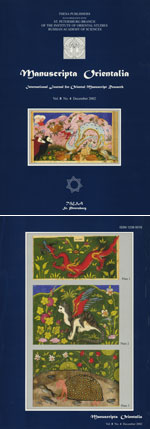|
|
| |

|

|
Petrosyan I. The Author and the Book: the Turkish Translation of Sa’dī’s Gulistān // Manuscripta Orientalia. Vol. 8, No 4, December 2002. P. 3-20.
The circumstances that inspired medieval Muslim authors to engage in creative work are always individual, although they are often similar. Turkish authors are no exception. Unfortunately, the authors themselves are usually too laconic in their explanations of the reasons that compelled them to take up the pen. The personal and individual are elusive in their works, although the texts themselves, whether their authors wished it or not, can tell us a great deal about the creators of these compositions. One can only add to this that the individual elements disappears almost entirely in translated works. The author of the translation dissolves without a trace in the text he translates. As we read the traditional, streamlined formulae the translators use to explain their reasons for translating, we can only guess at the real reasons they picked up the pen. They may be deeply buried in the culture itself, or there may be psychological motives for the creative impulse and the translation of a specific work. The individual, personal element is deeply hidden in Muslim literature, although one finds exceptions. In the marvelous Bābur-nāma (Records) by Bābur, for example, the person of the author sparkles like a diamond, illuminating the thoughts and feelings of people from the medieval Muslim East. But Bābur’s Records are not a translation. They are an original, autobiographical work.
Medieval Muslim texts appeared in a cultural context. They contain intellectual subtexts that are of interest to the modern researcher. What we know about the era and its culture can illuminate these contexts, just as what we know about the author can assist us. Of course, the task of obtaining this knowledge is more difficult when we deal with a translation. Yet it is not a hopeless task. Information about the author makes available to us the concealed, underlying characteristics of the views held by the authors of Muslim works as carriers of their own culture.
As I explored the Turkish manuscript collection at the St. Petersburg Branch of the Institute of Oriental Studies, my attention was drawn by a copy of the Turkish verse translation of Sa’dī’s Gulistān. It was done by the seventeenth-century Turkish poet Da‘ifī… PDF-files PDF-files
The entire paper
Keywords
Da‘ifī
Gulistān
Manuscripta Orientalia, selected papers
Sa’dī
Turkish manuscrpts
|
|
|
|
Random news: Announcements |
|
The 46th Annual Session of Saint Petersburg Arabists will be held on April 8 and 10, 2024 at the IOM RAS. |
|
Read more...
|
|
|
|
|

